Email marketing remains one of the most effective digital marketing channels. Among the numerous platforms available, Mailchimp has long been a popular choice for businesses seeking to send newsletters, automate campaigns, and grow their audience. But as email marketing evolves, many users are exploring other platforms better suited to their unique needs.
In this guide, we'll dive into what Mailchimp offers, the top considerations when choosing an alternative, and the 10 best alternatives available today—including robust platforms like PosterMyWall, Stripo, and Constant Contact.
What is Mailchimp?
Mailchimp is a cloud-based email marketing service that enables businesses to manage and automate their email campaigns. It’s particularly popular among small to medium-sized businesses thanks to its ease of use and wide array of templates and features.
Key Features:
-
Drag-and-drop email builder: Design professional emails easily without any coding knowledge.
-
AI-generated content suggestions: Let Mailchimp’s AI draft engaging subject lines and email copy.
-
Pre-built email templates: Choose from hundreds of responsive, pre-designed layouts.
-
Advanced segmentation and personalization: Target the right audience based on user behavior and preferences.
-
A/B testing: Optimize performance with split testing for subject lines, content, and send times.
-
Email automation workflows: Automate customer journeys based on triggers and schedules.
-
Reporting and analytics dashboards: Monitor open rates, clicks, and engagement over time.
-
Integration with over 300 apps: Sync with CRMs, CMSs, social platforms, and more.
Despite its strong foundation, Mailchimp can be restrictive for users seeking more customization, affordable pricing at scale, or broader marketing functionality.
What to Consider When Selecting a Mailchimp Alternative?
When evaluating alternatives to Mailchimp, here are the critical factors to consider:
-
Ease of Use: Look for intuitive interfaces, drag-and-drop editors, and clear onboarding.
-
Template Customization: Ensure templates are both flexible and visually appealing.
-
Multi-Channel Capabilities: Seek platforms that support social media, SMS, and push notifications for comprehensive outreach.
-
Automation: Find tools offering conditional logic, behavioral triggers, and visual workflow builders.
-
Integrations: Check if the platform supports your eCommerce, CRM, and CMS tools.
-
Analytics & Reporting: Choose tools with robust dashboards that allow campaign optimization.
-
Scalability: Make sure the platform grows with your contact list and marketing complexity.
-
Pricing: Compare pricing tiers, free trial availability, and hidden costs.
-
Support & Community: Evaluate customer support responsiveness, documentation quality, and community forums.
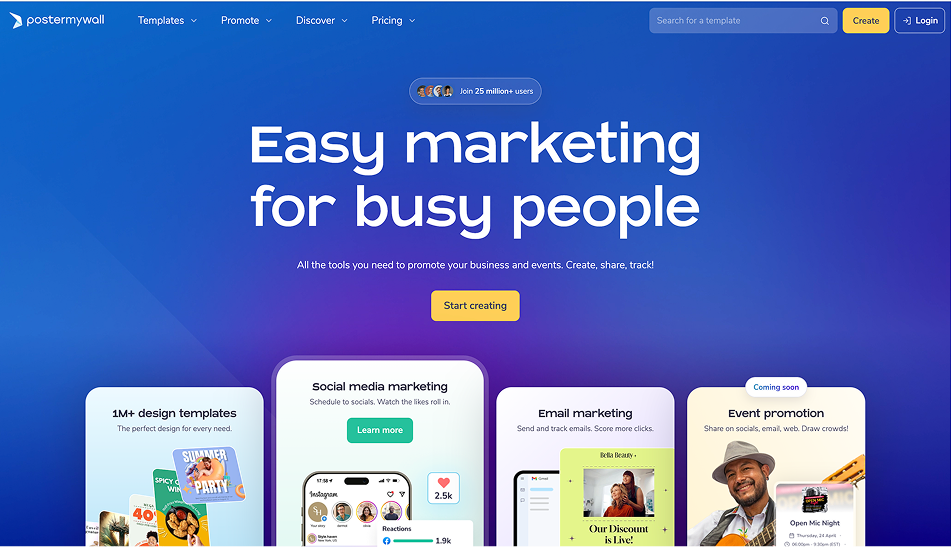
Pros:
-
User-Friendly Design Editor: PosterMyWall's drag-and-drop editor requires no design experience, making it ideal for small businesses. Users can easily create email campaigns from professionally designed templates.
-
Integrated AI Tools: Built-in AI assists with writing catchy subject lines, formatting content, and choosing relevant visuals, saving time and improving performance.
-
Multichannel Marketing Hub: Users can send emails and publish content across social platforms and digital signage, making PosterMyWall more than just an email tool.
-
Scheduling and Automation: PosterMyWall allows for recurring email campaigns, ensuring consistent engagement without manual effort.
-
Rich Template Library: With over 1 million templates, it supports virtually any industry or use case.
Cons:
-
Basic CRM Features: Lacks advanced lead scoring and detailed customer profiles that platforms like HubSpot offer.
-
Simplified Reporting: Analytics are effective for basic performance tracking but lack granular segmentation and behavioral metrics.

Pros:
-
Modular Email Builder: Users can build reusable email components (modules) that streamline future campaigns.
-
AMP Email Support: Enables interactive content like forms, image carousels, and ratings within emails.
-
Wide Export Capabilities: Supports export to 70+ platforms, including Mailchimp, HubSpot, Salesforce, and more.
-
Litmus & Email on Acid Integration: Provides robust rendering tests to ensure compatibility across devices.
Cons:
-
No Email Sending Features: Stripo focuses solely on design. Users must rely on external platforms to send emails.
-
Steep Learning Curve: The depth of customization may overwhelm beginners unfamiliar with HTML or email rendering standards.

Pros:
-
Sleek Drag-and-Drop Interface: Simplifies the creation of polished, mobile-optimized emails.
-
Reusable Blocks and Branding Kits: Great for maintaining brand consistency across campaigns.
-
Team Collaboration Tools: Real-time editing, commenting, and approval workflows help streamline team productivity.
-
Export Flexibility: Allows exports to platforms like Mailchimp, Salesforce, and Constant Contact.
Cons:
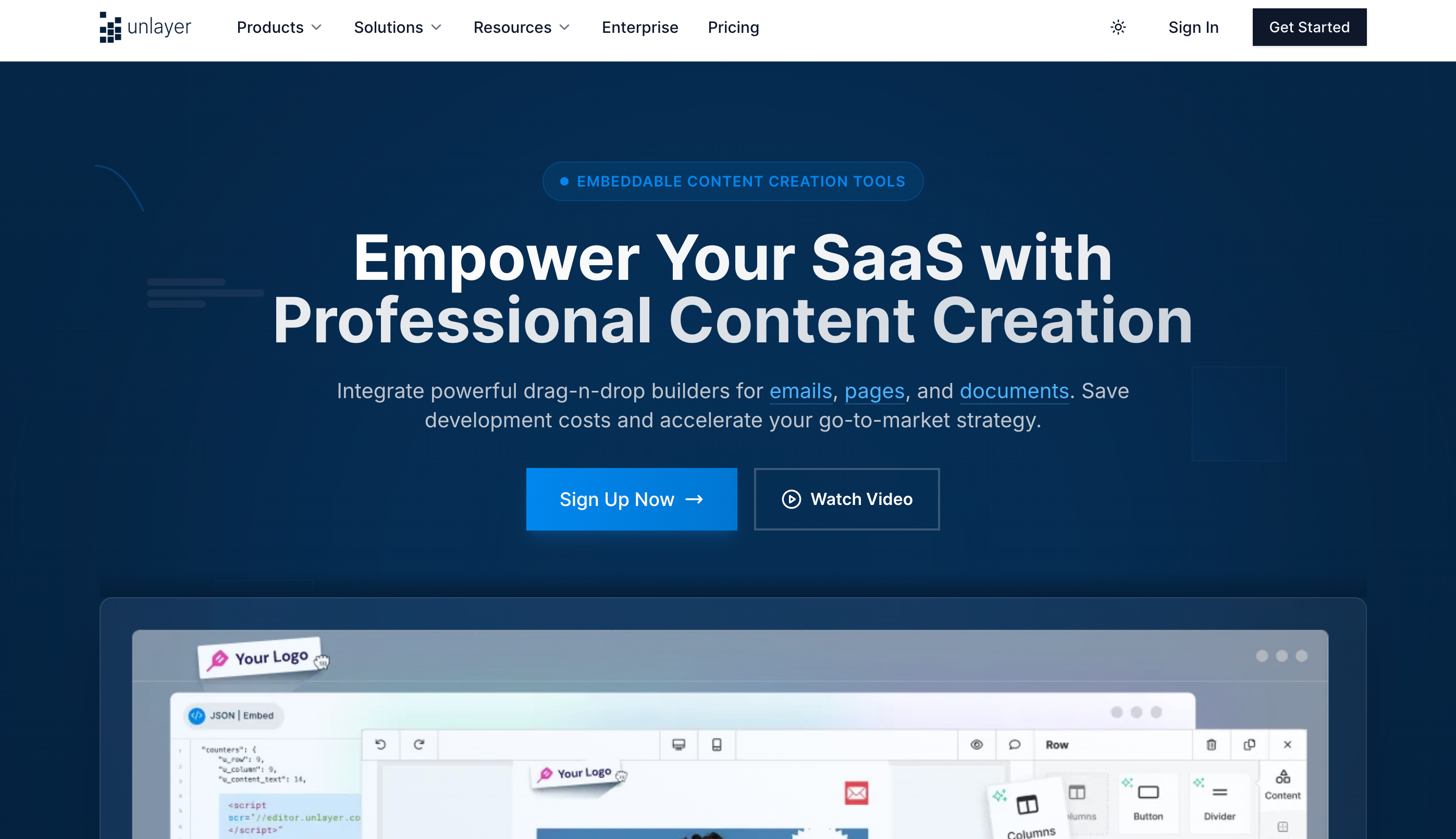
Pros:
-
Embeddable Editor for SaaS: Developers can embed Unlayer into their CRM or app for a seamless customer experience.
-
Custom HTML and Blocks: Advanced users can add their own HTML or pre-defined custom content blocks.
-
Brand Kit Support: Helps maintain visual consistency with saved fonts, colors, and logos.
Cons:
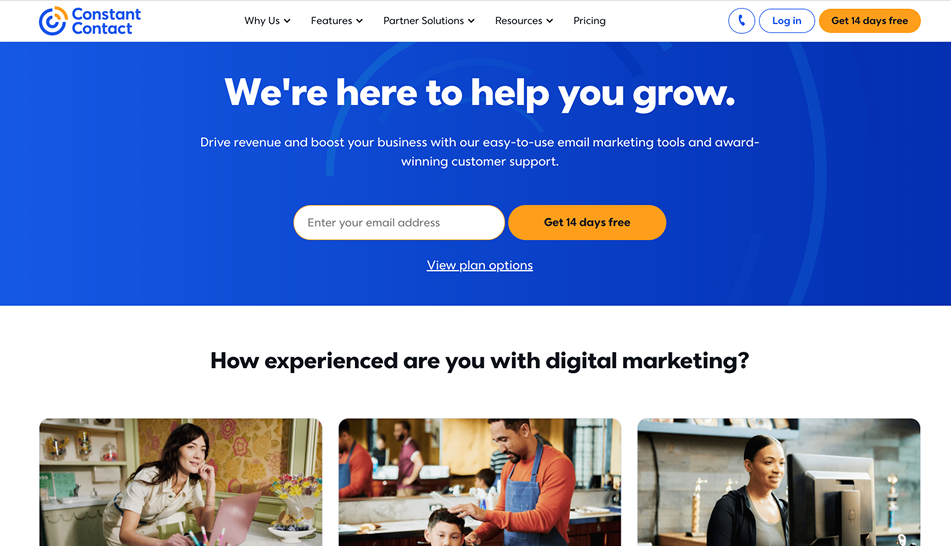
Pros:
-
All-in-One Marketing Suite: Includes email marketing, social media posting, surveys, polls, and even event marketing, making it a versatile option for multi-channel campaigns.
-
Extensive Template Gallery: Offers hundreds of professionally designed templates that are mobile-responsive and customizable.
-
List Building Tools: Includes landing pages, sign-up forms, and integrations to grow and segment contact lists easily.
-
High Deliverability Rates: Known for strong inbox placement and dependable email sending infrastructure.
Cons:
-
Limited Automation Features: Workflow automation is more basic compared to platforms like HubSpot or GetResponse.
-
Higher Cost for Premium Features: Some essential features like surveys or A/B testing are only available in higher-priced plans.
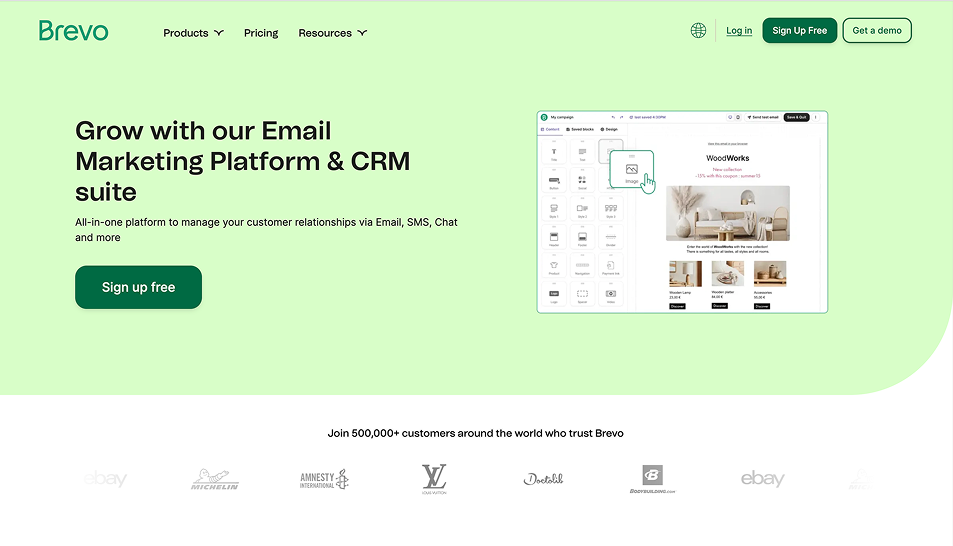
Pros:
-
Transactional Messaging Capabilities: Supports marketing emails as well as transactional SMS and email messages via SMTP.
-
Robust Automation Tools: Includes advanced logic-based workflows that can trigger emails based on user behavior, lead scoring, and more.
-
Scalable Pricing: Charges based on the number of emails sent rather than number of contacts, ideal for businesses with large lists.
-
Built-in CRM and Live Chat: Provides customer tracking and real-time communication tools all within one dashboard.
Cons:
-
Complex Interface for Beginners: The extensive features can feel overwhelming to new users or small businesses.
-
Design Limitations: Email builder is functional but less refined compared to PosterMyWall or Stripo.
![]()
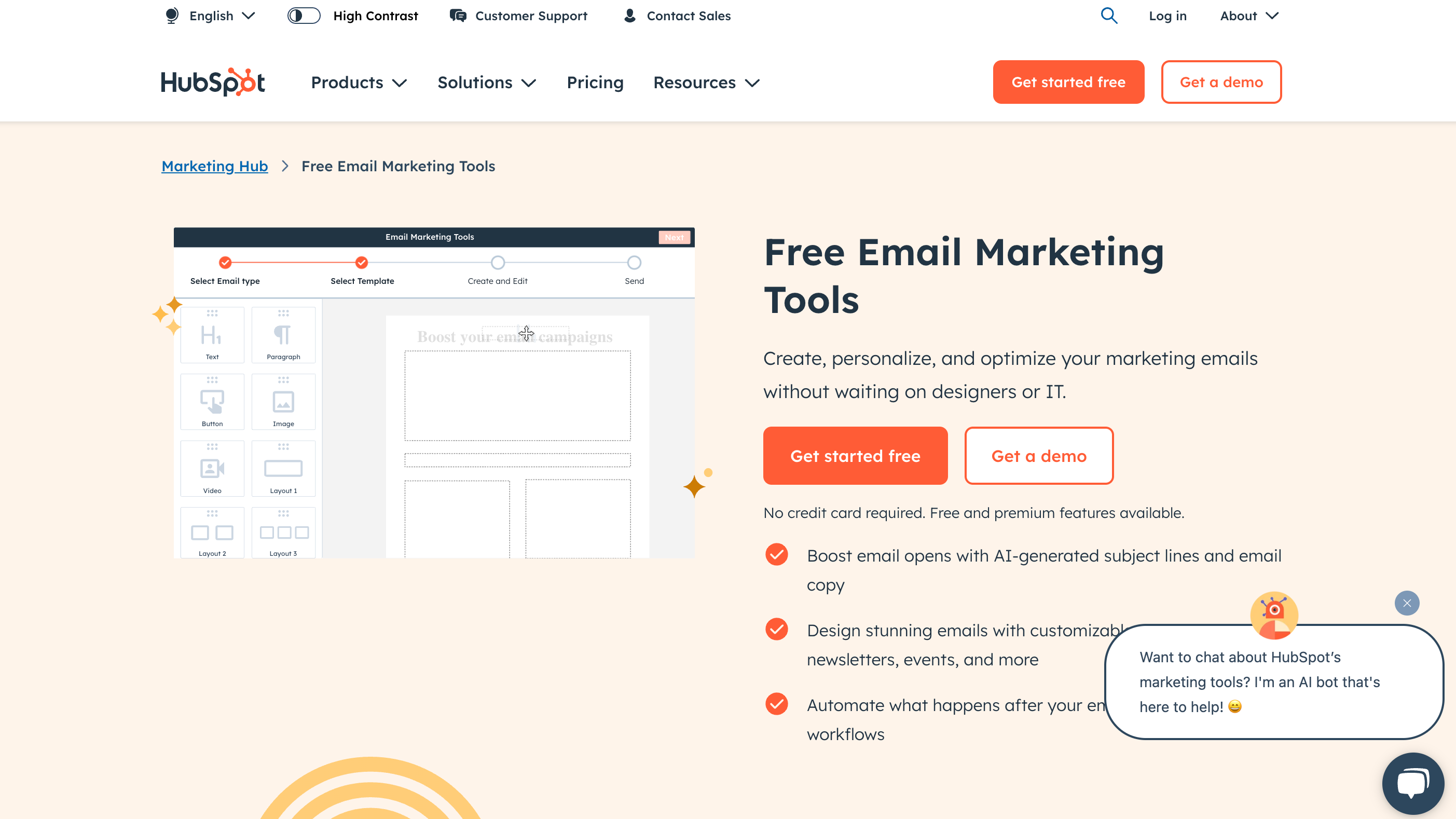
Pros:
-
CRM Integration: Fully integrated with HubSpot CRM, allowing precise targeting and seamless contact management.
-
Advanced Personalization and Smart Content: Enables dynamic email content based on user data, behaviors, or lifecycle stage.
-
Comprehensive Analytics: Includes campaign reporting, contact activity tracking, and ROI analytics tied directly to sales outcomes.
-
Educational Resources and Support: Extensive library of courses, documentation, and 24/7 support.
Cons:
-
High Cost for Full Features: Advanced marketing tools require higher-tier subscriptions, making it cost-prohibitive for small teams.
-
Overhead for Simple Use Cases: May be excessive if you're only looking for basic email marketing capabilities.

Pros:
-
Powerful Autoresponder and Funnel Builder: Create complex automation workflows and entire sales funnels from landing page to purchase.
-
Webinar Integration: Unique among email platforms, includes webinar hosting and registration tools.
-
Conversion Optimization Tools: A/B testing, lead scoring, and audience segmentation available in all tiers.
-
eCommerce Integration: Works well with Shopify, Magento, WooCommerce, and more.
Cons:

Pros:
-
Creator-Focused Features: Designed for authors, bloggers, podcasters, and creators with features like tip jars and paid newsletters.
-
Simplified Email Automation: Visual automation builder makes it easy to set up nurture sequences and broadcasts.
-
Tag-Based Segmentation: More flexible than list-based models, allowing detailed tracking of subscriber behavior.
-
Native Integrations: Connects with Teachable, Patreon, and other creator-first platforms.
Cons:
-
Minimal Design Customization: Email templates are plain, with fewer visual styling options.
-
No A/B Testing on Lower Plans: Requires upgrading for full access to performance testing tools.
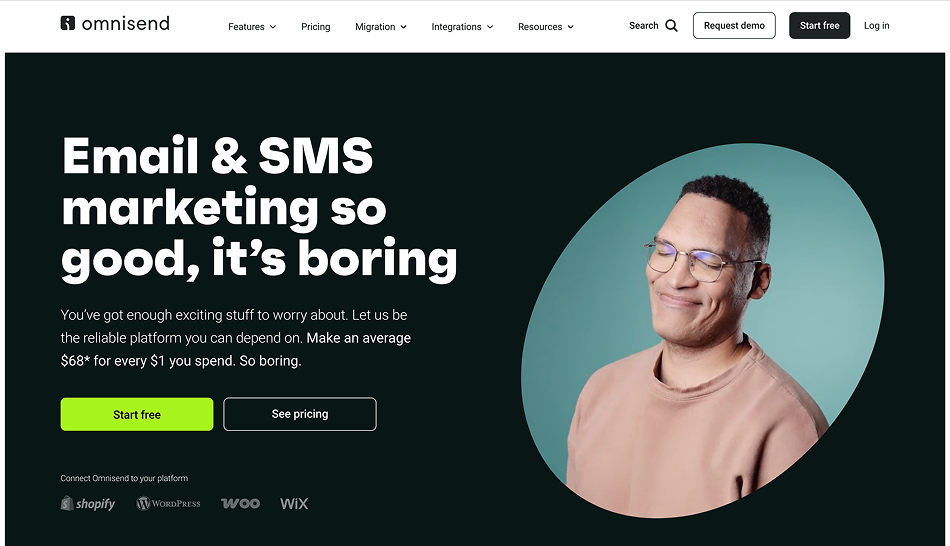
Pros:
-
Ecommerce Specialization: Tailored for online retailers with features like product pickers, dynamic coupons, and cart recovery workflows.
-
Multichannel Support: Integrates email, SMS, and push notifications in unified workflows.
-
Drag-and-Drop Editor: Designed specifically for eCommerce needs with built-in product recommendations.
-
Strong Shopify Integration: Deep integration with Shopify and BigCommerce allows real-time product syncing and performance tracking.
Cons:
-
Limited Free Plan: Some powerful features, including SMS marketing and A/B testing, are restricted to premium tiers.
-
Learning Curve for Automation: The automation builder is powerful but requires time to fully master.
Final Verdict: Which Mailchimp Alternative Should You Choose?
Your perfect Mailchimp alternative depends on your specific needs. If you’re looking for simplicity, affordability, and AI-powered ease of use, PosterMyWall is an excellent place to start. It offers smart automation, easy publishing across channels, and powerful design tools in one package—ideal for busy entrepreneurs and small business owners.
Each platform has its unique strength, whether it’s automation, CRM, or design flexibility. Test a few with free trials to see what clicks best.
But if you're looking for an intuitive, all-in-one marketing tool with robust email features, look no further than PosterMyWall.